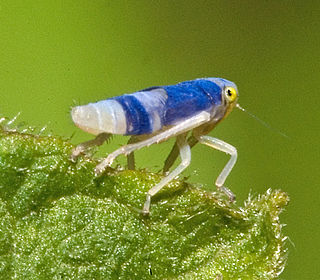
The Restionaceae, also called restiads and restios, are a family of flowering plants native to the Southern Hemisphere; they vary from a few centimeters to 3 meters in height. Following the APG IV (2016): the family now includes the former families Anarthriaceae, Centrolepidaceae and Lyginiaceae, and as such includes 51 genera with 572 known species. Based on evidence from fossil pollen, the Restionaceae likely originated more than 65 million years ago during the Late Cretaceous period, when the southern continents were still part of Gondwana.

Leafhopper is the common name for any species from the family Cicadellidae. These minute insects, colloquially known as hoppers, are plant feeders that suck plant sap from grass, shrubs, or trees. Their hind legs are modified for jumping, and are covered with hairs that facilitate the spreading of a secretion over their bodies that acts as a water repellent and carrier of pheromones. They undergo a partial metamorphosis, and have various host associations, varying from very generalized to very specific. Some species have a cosmopolitan distribution, or occur throughout the temperate and tropical regions. Some are pests or vectors of plant viruses and phytoplasmas. The family is distributed all over the world, and constitutes the second-largest hemipteran family, with at least 20,000 described species.

The Cape Floral Region is a floristic region located near the southern tip of South Africa. It is the only floristic region of the Cape Floristic Kingdom, and includes only one floristic province, known as the Cape Floristic Province.

The superfamily Membracoidea of sap-sucking true-bugs includes two of the largest families within what used to be called the "Homoptera": the leafhoppers (Cicadellidae) and the treehoppers (Membracidae). The other families in this group are quite small, and have, at various points, generally been included as members within other families, though they are all presently considered to be valid, monophyletic groups. The relict family Myerslopiidae is restricted to New Zealand and South America while the Melizoderidae consist of two genera restricted to South America. The great diversity of Neotropical taxa suggests that the group originated in that region.
Urmila was the wife of Lakshmana, one of the three younger brothers of Rama in the Indian epic Ramayana.

Deltocephalinae is a subfamily of leafhoppers. Deltocephalinae is the largest subfamily in the family Cicadellidae and is divided into 40 tribes, comprising over 925 genera, and over 6,700 described species.

Apodasmia similis, also known as oioi or jointed wire rush, is a plant that is endemic to New Zealand. It is a coastal plant but is also found around peat bogs and hot springs. It flowers from October to December and bears fruit from December to March.
Recilia is a genus of bugs from the family Cicadellidae, recorded mostly from Africa, the West Palaearctic and New Zealand. As of Webb & Viraktamath (2009), the vast majority of former species, includong the zig-zag leafhopper of rice R. dorsalis, are now placed in the genus Maiestas. Before this, the genus was sometimes treated as a subgenus of Deltocephalus, of the same tribe.

Willdenowia is a small genus of flowering plants in the family Restionaceae described as a genus in 1790. The entire genus is endemic to the fynbos of the Western Cape Province of South Africa.

Ulopinae is a subfamily of leafhoppers.
Cicadulina is a leafhopper genus in the tribe Macrostelini.

Typhlocybinae is a subfamily of insects in the leafhopper family, Cicadellidae. This is currently the second largest leafhopper subfamily based on the number of described species, but researchers believe there are so many taxa yet undescribed that it is probably the largest subfamily. Approximately 6000 species have been described thus far.

Chandrashekaraswami Adiveyya Viraktamath is an Indian entomologist who specializes in the systematics of leaf-hoppers, Cicadellidae. He served as a professor of entomology at the University of Agricultural Sciences, Bangalore.
Bonaspeiini is a tribe of leafhoppers in the subfamily Deltocephalinae. Bonaspeiini is made up of 26 genera and over 125 species found throughout southern Africa. Many species are found in the fynbos biome.
Xerophytacolus is a genus of Cicadellidae (leafhopper) in the tribe Opsiini and the subfamily Deltocephalinae. It was described in 2012 by Stiller, and is found in southern Africa.










